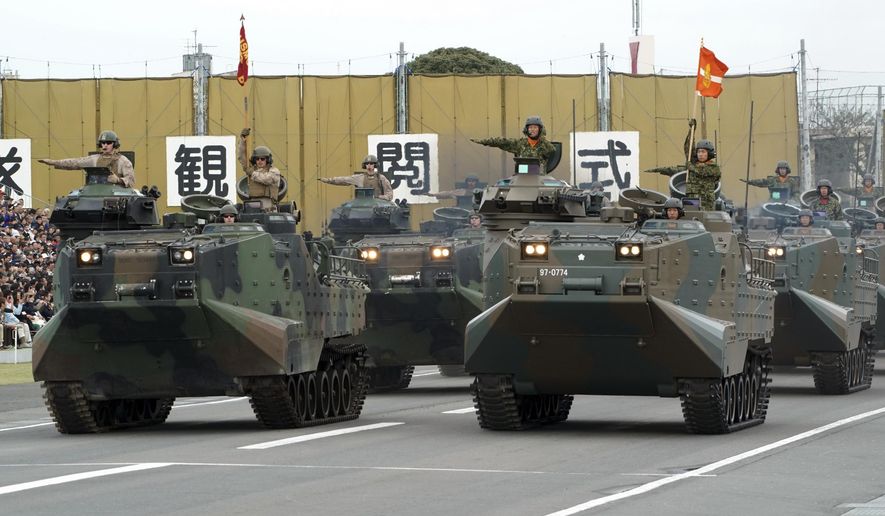 Japan emerged from World War II as a crushed survivor of its own ambition and cruelty, despised by the Asia it described as a “partner” in the Greater East Asia Co-Prosperity Sphere. Asia was a very junior “partner” indeed.
Japan emerged from World War II as a crushed survivor of its own ambition and cruelty, despised by the Asia it described as a “partner” in the Greater East Asia Co-Prosperity Sphere. Asia was a very junior “partner” indeed.
The Japanese military that fought World War II is remembered for the rape and pillage not only of Nanking but in the sacking of Manila, “the Pearl of the Orient” that Douglas MacArthur had declared an open city and evacuated his army to save it. Japanese troops leveled it to a smoking ruin.
When the war was over, the new Japan, under the tutelage of MacArthur, declared never again, and adopted a constitution, still in force, that abjures all military force. But that’s only part of the story. Tokyo, encouraged and further tutored by the United States, now commands one of the most powerful military establishments in the world. Its weapons research development sets the pace in some areas.
The Japan Self-Defense Forces, established in 1954, ranks as the world’s fourth most-powerful military in conventional capabilities, with the eighth-largest military budget. In recent years Japan has participated in United Nations peacekeeping operations, and its highly trained and equipped amphibious rapid deployment brigade — which expects to train 3,000 men by the end of next month — has just completed a joint exercise with U.S. forces.
Rising Cold War tensions in Europe and Asia, coupled with leftist-inspired strikes and demonstrations in Japan, prompted conservative leaders to question the unilateral renunciation of all military capabilities in the surrender treaty with the United States and the Allies. When many American occupation troops were moved to Korean War duty, Japan developed a close mutual defense relationship with the United States.
Encouraged by the Americans, the Japanese government in 1950 authorized the establishment of a National Police Reserve, consisting of 75,000 men equipped with light infantry weapons. In 1952, Coastal Safety Force, the waterborne counterpart of the police reserve, was organized and in 2006 the Japanese military establishment became the full-fledged cabinet-level Ministry of Defense.
A year later Japanese military operations were revised from “miscellaneous regulations” to “basic duties,” finally recognizing that the nation’s military was no longer restricted solely to defense. Japanese ships are now dispatched worldwide, for example, to deal with pirates who have imperiled commercial shipping. Japan established its first postwar overseas base at Djibouti, in Somalia, in 2010.
Japan and the United States conducted their largest military exercise, called Keen Sword, last year, with 47,000 American seamen, Marines and airmen joined by 47,000 Japanese. A naval supply ship and frigate of the Royal Canadian Navy also participated in simulations of air combat, ballistic missile defense and amphibious landings.
In 2004, at the behest of the United States, Japan deployed troops to Iraq in the U.S.-led reconstruction of Iraq. This was the first time since the end of World War II that Japan had sent troops abroad, except for a few minor U.N. peacekeeping deployments.
Last December the government adopted a budget for fiscal 2019 that includes 100 trillion yen, or $900 billion, for the military. There is no secret about what motivates Japanese policy to turn its back on the postwar professions of neutrality and to reject the idea of any military establishment. It’s the growing perceived threat from Communist China.
In addition to conventional weaponry, the defense budget for fiscal 2018 included funds to purchase mid- to long-range air-launched cruise missiles. Defense Minister Itsunori Onodera said they would be used exclusively for defense as “stand-off missiles that can be fired beyond the range of enemy threats.” But the budget allocated another $20 million for the purchase of Joint Strike Missiles for its American-made F-35A stealth fighters and $270,000 for research on modifying existing Japanese Mitsubishi F-15J fighters to carry long-range anti-ship missiles and extended-range air-to-surface standoff missiles.
The Ministry of Defense is developing supersonic glide bombs to strengthen the defense of Japan’s remote islands, including the Senkaku Islands between Japan and Korea. The anti-surface strike capability will assist in amphibious landing and recapture operations on remote islands. Japan’s Defense Ministry has also allocated $57 million for research and development of a hypersonic missile which could travel five times the speed of sound, Mach 5, or faster. A scramjet engine prototype, jet-fuel technology and heat-resistant materials will be built by 2025.
Japanese public opinion about all this is sharply divided. The Japanese people relish their new reputation as peace-loving folk who wouldn’t harm a fly — or dispatch a flying missile. But it’s a new world out there, as well as a new Japan.
No comments:
Post a Comment